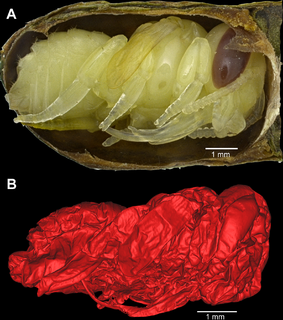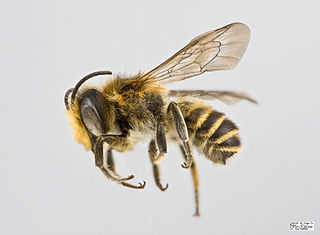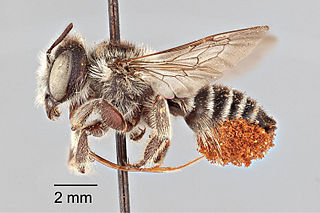
Megachilidae is a cosmopolitan family of mostly solitary bees whose pollen-carrying structure is restricted to the ventral surface of the abdomen. Megachilid genera are most commonly known as mason bees and leafcutter bees, reflecting the materials from which they build their nest cells ; a few collect plant or animal hairs and fibers, and are called carder bees, while others use plant resins in nest construction and are correspondingly called resin bees. All species feed on nectar and pollen, but a few are kleptoparasites, feeding on pollen collected by other megachilid bees. Parasitic species do not possess scopae. The motion of Megachilidae in the reproductive structures of flowers is energetic and swimming-like; this agitation releases large amounts of pollen.

William (Wilhem) Nylander was a Finnish botanist and entomologist. Nylander was born in Oulu, and taught at the University of Helsinki before moving to Paris, where he lived until his death in 1899.

Megachile pluto, also known as Wallace's giant bee or raja ofu, is a very large Indonesian resin bee. It is the largest known living bee species. It was believed to be extinct until several specimens were discovered in 1981. No further sightings were confirmed until two specimens were collected and sold on eBay in 2018. A live female was found and filmed for the first time in 2019.

The genus Megachile is a cosmopolitan group of solitary bees, often called leafcutter bees or leafcutting bees; it also includes the called resin bees and mortar bees. While other genera within the family Megachilidae may chew leaves or petals into fragments to build their nests, certain species within Megachile neatly cut pieces of leaves or petals, hence their common name. This is one of the largest genera of bees, with more than 1500 species in over 50 subgenera. The introduced alfalfa leafcutter bee is managed for crop pollination in various regions around the world.

Megachile campanulae, known as the bellflower resin bee, is a species of bee in the family Megachilidae. Described in 1903, these solitary bees are native to eastern North America. Studies in 2013 placed them among the first insect species to use synthetic materials for making nests. They are considered mason bees, which is a common descriptor of bees in several families, including Megachilidae. Within the genus Megachile, frequently also referred to as leafcutter bees, M. campanulae is a member of the subgenus Chelostomoides, which do not construct nests from cut leaves, but rather from plant resins and other materials. Females lay eggs in nests constructed with individual cell compartments for each egg. Once hatched, the eggs progress through larval stages and subsequently will overwinter as pupae. The bees are susceptible to parasitism from several other bee species, which act as brood parasites. They are medium-sized bees and the female adults are typically larger than the males. They are important pollinators of numerous native plant species throughout their range.
Megachile angelarum is a species of bee in the Megachilidae family.
Chelostomoides is a subgenus of bees in genus Megachile. These bees do not cut leaves, but rather, use resin, mud, or other materials
Megachile analis is a species of bee in the family Megachilidae. It was described by Nylander in 1852.
Megachile fulvimana is a species of bee in the family Megachilidae. It was described by Eduard Friedrich Eversmann in 1852.

Megachile gentilis is a species of bee in the family Megachilidae. It was described by Cresson in 1872.
Megachile melanogaster is a species of bee in the family Megachilidae. It was described by Eduard Friedrich Eversmann in 1852.
Megachile rotundiventris is a species of bee in the family Megachilidae. It was described by Perris in 1852.
Megachile sericans is a species of bee in the family Megachilidae. It was described by Fonscolombe in 1852.

Megachile centuncularis, commonly known as the patchwork leafcutter bee, is a species of bee in the family Megachilidae. It was first described by the Swedish naturalist Carl Linnaeus in 1758.

Megachile oenotherae is a species of bee in the family Megachilidae. It was described by Mitchell in 1924.
Megachile umatillensis is a species of bee in the family Megachilidae. It was described by Mitchell in 1927.

Megachile willughbiella, Willughby's leaf-cutter bee is a species of bee in the family Megachilidae. It was described by the English entomologist William Kirby in 1802; he named it in honour of the ornithologist Francis Willughby.








